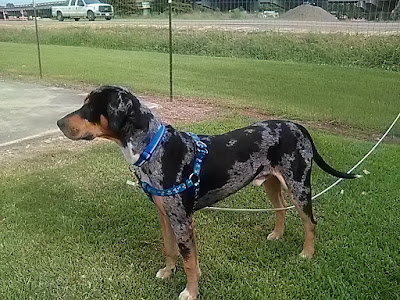Wednesday, May 8, 2019
The Blair-bred Catahoula
About 8 or 10 years ago, I was advised by an old master trainer to bring the Blair bred bloodline into my kennel and cross them with my Maurice line. I have not regretted following that advice , but I must admit it was a challenge to make the adjustment. Because thee Blair bloodline is so well bred and has determination and grit like I never saw in any other bloodline.
Above is de la Houssaye's Valyrie, a great-granddaughter of Diamond Cutter
The Blair bred Catahoula has affected my breeding and training program so much it is like a whole new breed for me.
Above is Amos Mann and Blair's Diamond Cutter
The first thing I noticed was that almost every dog was capable of finding, stopping and holding a hog all by themself and at a very young age. It was like it was a natural instinct instead of something learned in experience. Hence the importance of breeding over training.
The next big revelation, was that I realized these dogs are smarter than me. I also learned that I could not be as harsh in my disciplinary actions as I had been with my old bloodlines. Because of a high level of wolf in the genes of the Blair bred dog, they are very sensitive to neglect, abuse and disrespect. On the other hand if you raise them up as a pup, and spoil them and make them a part of the family, they will live to please you, and die defending you if you are down.
Above is Hoyt Ferguson from Missouri and a descendent of Diamond Cutter
To properly handle these dogs one must understand the pack instinct and how that affects their behavior. In the wild, a wolf's natural instinct is to chase, catch, and kill. In the event that the prey cannot be caught, the lone wolf bays to weaken the prey and to alert the rest of the pack regarding the whereabouts of the hog. Because barking on the track would alert the game to the location of the hog and predator dog, wolves are almost always silent on the track. In essence, baying is something that must be learned from watching older dogs.
Above is a descendent of Cutter in Italy. Amas and Susan sent a Cutter pup to Italy many years ago.
Another thing I learned by observing pack behavior was that the "leader" of the pack was not in the front in a hunt. The leader of the pack allows the younger, more energetic members of the hunt to go out in front and find, and chase the game down. After the younger dogs stop the running hog, the older dog will observe the bay from a distance for two reasons.
Number 1, he stays back to wait for the hog to tire out, and not put too much pressure on the hog causing it to bust out and try to run again. Number 2, the older, leader of the pack is not as much a finder and chaser as the younger dogs, he is a killer. He waits for the hog to tire out at the bay and then makes his move.
Above is NALC reg. C Arrow Patch
By saving his energy for the kill he is much more effective in accomplishing a swift kill and avoiding injury to himself or other members of the pack.
Above is Scudder, a great-grandson of Cutter
I am Marcus de la Houssaye and I can be reached by email at catahoula1@gmail.com
Subscribe to:
Post Comments (Atom)














No comments:
Post a Comment